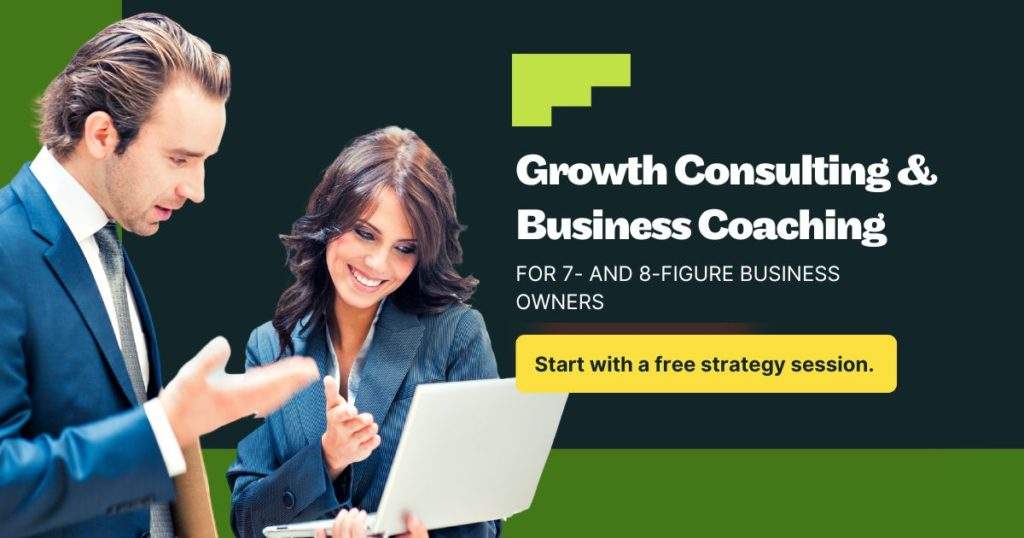According to a research study conducted among Predictable Profits clients, 7.5% of marketing-qualified leads convert between zero and 90 days. But 42.5% of MQLs buy between 90 days and two years from now.
The problem is that most business owners want leads to convert immediately and often ignore them when they don’t.
The above study emphasizes the importance of understanding buyers buy on their own time (not yours). You needing sales now doesn’t mean your leads are ready to buy. However, plenty of them will later during their buyer journey.
In fact, according to our study, the average MQL takes 11.8 months to convert from first contact.
Buyers Go Everywhere For Information
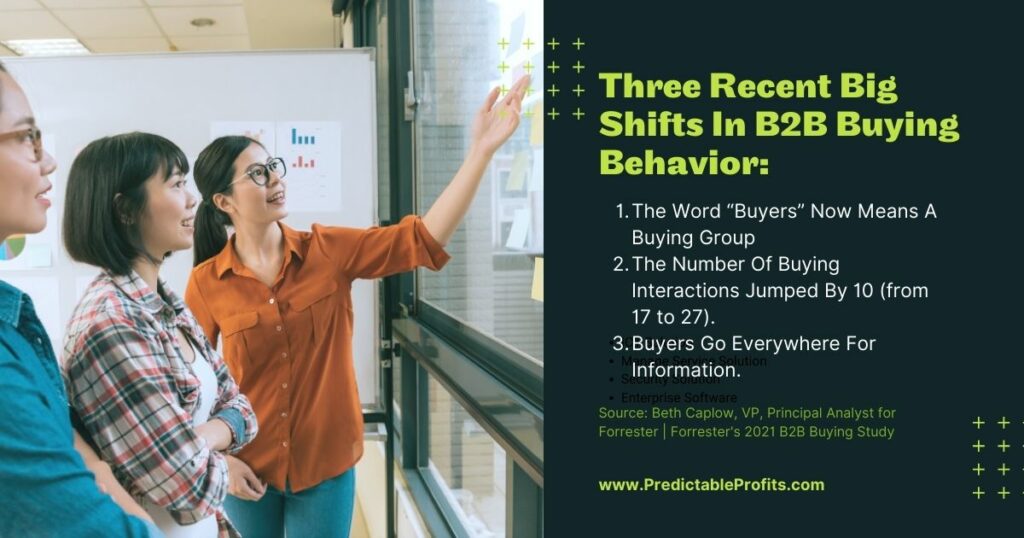
The buying process has always been complicated. But the past few years brought additional challenges and revealed significant changes in buying behavior.
According to a recent Forrester study, buyers having a wealth of information at their fingertips means they do lots of self-directed research. They use sources such as
- social media
- syndicated content (via blogs, videos, infographics, etc.)
- category- or industry-specific resources
- forums and discussion boards
- webinars and online events
- peer discussions
- industry experts
- various provider representatives
Today’s buyers are researchers. The number of buying interactions jumped during the pandemic from 17 to 27– a reflection of the journey consumers now make to gain information about competing offerings or providers before purchasing.
Buyers Constantly Move Between Exploration and Evaluation
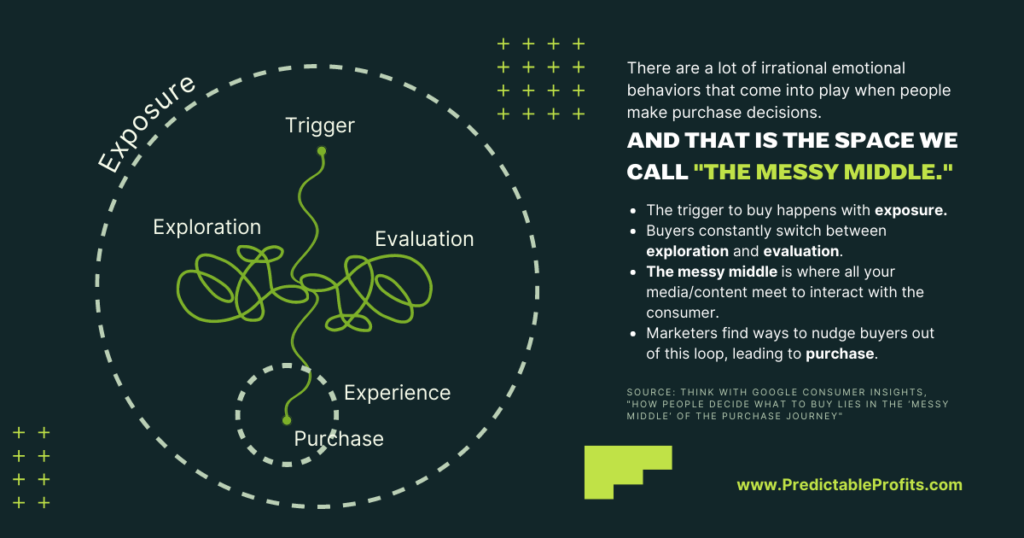
An extensive study on consumer behavior done by Google sought to understand the muddled path of the buyer’s journey between trigger and purchase.
Google refers to the tangled space between trigger and purchase as “the messy middle.” This entails everything consumers think, see, do, and research, which influences the time they think, “I need to buy something,” and actually make the purchase.
And within this “messy middle,” buyers do one of two actions: they either explore or evaluate. These two tasks can happen either simultaneously or sequentially. But they’re two distinct mental processes:
- The first is exploration, an expansive mindset where the buyer makes discoveries, gets new information and adds brands to their consideration set.
- The second is evaluation, which is a much more reductive exercise. Here, the buyer narrows down options.
Interestingly enough, on many occasions, consumers limit their options only to discover something — whether a new product or piece of information — that sends them back into exploration mode.
This infinite loop between exploration and evaluation can feel complicated (perhaps even frustrating) for marketers and business owners trying to initiate a purchase.
So what does the “messy middle” have to do with our featured adage, “buyers buy on their own time?”
According to Rachael Powell, Google AUNZ Head of Consumer Market Research, this messy middle “is a great example that demonstrates and reminds us that we, as marketers, can’t make assumptions or think we know what consumers are going to do. We have to look at their reality.”
![[The messy middle] is a great example that demonstrates and reminds us that we, as marketers, can't make assumptions or think we know what consumers are going to do - Predictable Profits](https://predictableprofits.com/wp-content/uploads/2022/10/The-messy-middle-is-a-great-example-that-demonstrates-and-reminds-us-that-we-as-marketers-cant-make-assumptions-or-think-we-know-what-consumers-are-going-to-do-Predictable-Profits-1024x538.jpg)
The concept of the “messy middle” corresponds to the idea of the dark funnel as well. As buyers jump between exploration and evaluation, much of this activity can’t be tracked via traditional means of attribution.
Read more about it here: “What is the Dark Funnel (And What Does it Have to Do With Your Marketing Efforts)?”
What Does The Phrase “Buyers Buy on Their Own Time (Not Yours)” Now Mean For You and Your Marketing Efforts?
To succeed in today’s market, you need to adapt to an evolving buying process.
As a leader and business owner, you have two choices regarding marketing strategy: serve existing demand or create new demand.
And according to digital marketing guru Rand Fishkin, “too many of y’all are focused (on serving existing demand).”
This is why demand generation is so important. You must be visible from the beginning of a buyer’s journey, as well as when they alternate between exploration and evaluation.
Your demand gen game plan should also include public relations, reaching out to influencers and media outlets, and publishing lots of relevant content online.
Many marketers and business owners confuse demand generation with lead generation. These are two different disciplines entirely, but the most important thing to remember is that both are crucial to helping you grow your business.
Read more about it here: “Demand Generation vs. Lead Generation: What’s the Difference?”
1. First, you must create demand.
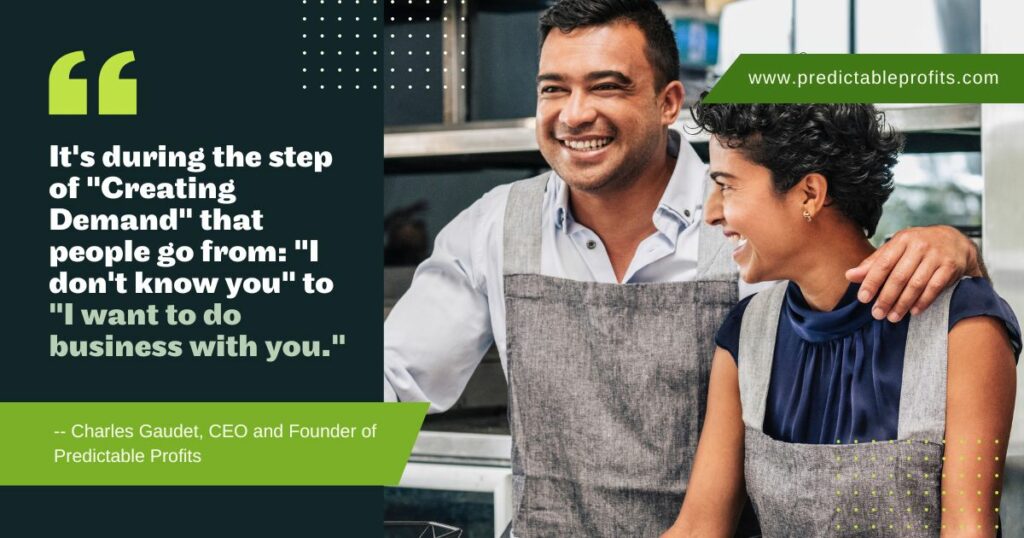
Through your content marketing efforts, you create demand — or interest — in your product or service while also being visible and staying top-of-mind.
This way, when someone makes a buying decision, they engage with you rather than your competitors.
- Many salespeople try to close deals too quickly, rushing the buying process to meet sales targets. This leads to lost opportunities.
- Instead, focus on building relationships with your prospects.
- Put relevant and helpful content in front of people as often as possible and on as many mediums as possible.
Remember: it’s during the step of “Creating Demand” that people go from: “I don’t know you” to “I want to do business with you.”
We talked about the importance of not being sales-y or not resorting to the tired, traditional way of doing sales.
Read more about it here: “How Do I Convert More Leads Into Customers (Without Being Too Sales-y)?”
2. Next, you must capture demand.
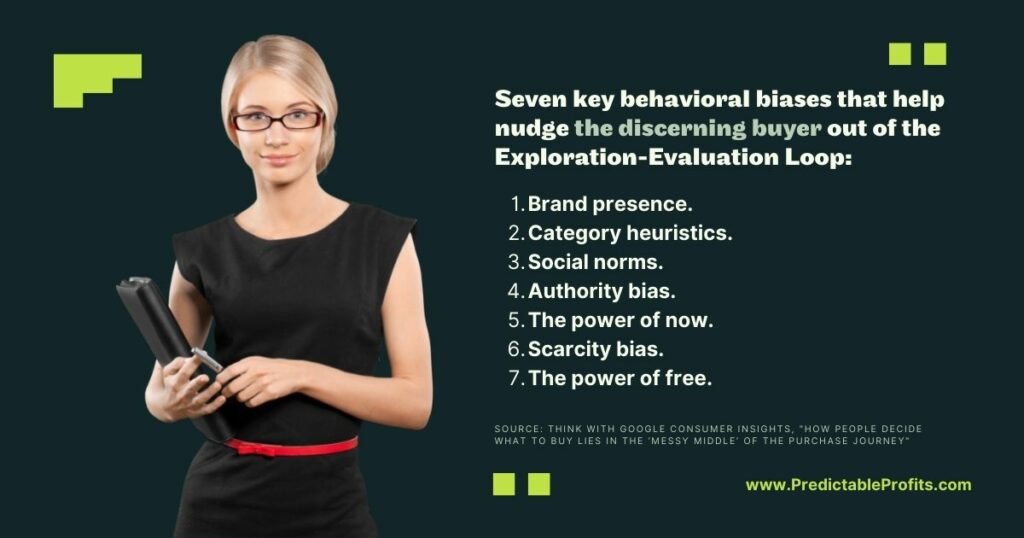
To do this, you need a plan and the right tools in place.
This includes a website designed for conversions, with clear calls-to-action (CTAs) that lead prospects to valuable content offers such as eBooks, guides, and webinars.
The Google study mentioned earlier identifies seven key behavioral biases that influence how consumers make decisions (and, ultimately, nudges them out of the exploration-evaluation loop).
- Brand presence. Simply being visible during the exploration-evaluation loop can impact buying behavior. As humans, we’re more likely to trust what we know and repeatedly see.
- Category heuristics. Buyers rely on shortcuts or rules-of-thumb (heuristics, if you will) to help make quick and easy decisions. Because buyers have many options, they simply don’t have time to systematically review and analyze everything.
- Social norms. Consumers tend to adopt the opinions and follow the behaviors of the majority. This is also known as the “herd instinct” or the idea that people look to others’ actions as a shortcut for their own decision-making. This is why social proof — such as ratings and reviews — has a strong impact on consumer behavior.
- Authority bias. Besides our peers, we also look to people in positions of authority for guidance on buying decisions. We tend to follow the lead of those perceived to be credible and knowledgeable experts.
- The power of now. There’s no time like the present. So create urgency when possible. Humans are wired to live in the present.
- Scarcity bias. Simply put, resources in low supply are more desirable. Google’s research confirms that limited-time-only offers are effective.
- The power of free. Free items create appeal and can disproportionately affect buyers’ decision-making.
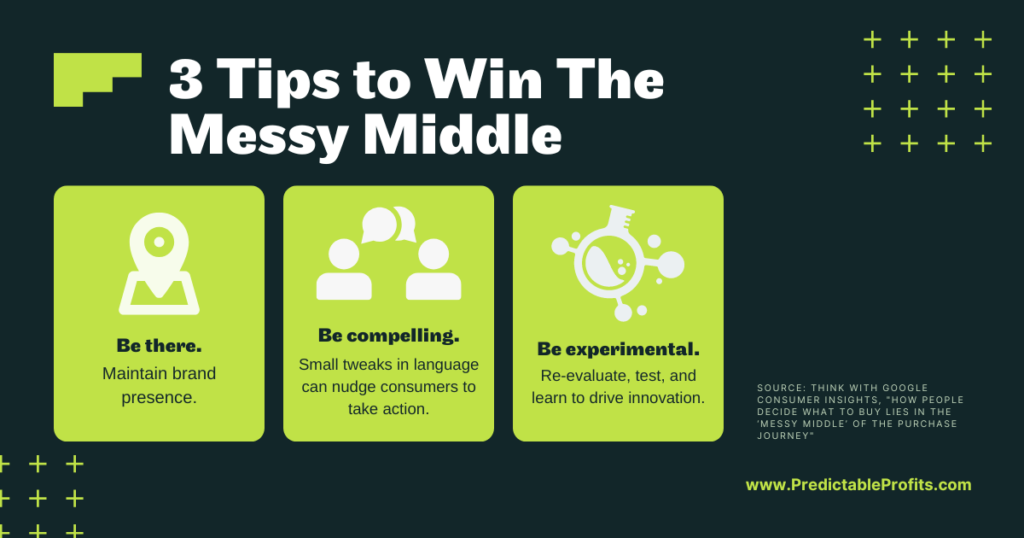
Employing these seven behavioral biases in your sales strategy, messaging, or content marketing can drive your buyers further toward conversion.
3. Finally, you must nurture demand.
We often refer to figures presented by Chet Holmes in his New York Times bestselling book, “The Ultimate Sales Machine.”
When it comes to an audience of potential buyers, Holmes stressed that:
- 3% are interested in buying right now,
- 7% are open to buying from you,
- 30% are not even thinking about you (or your products/services),
- 30% don’t think they’re interested,
- and 30% are definitely not interested at all.
This means if you launch a campaign right now, expect about 10% of your target audience to be interested in what you offer — 3% could buy right away and another 7% later on.
Many sales professionals miss the opportunity presented by the other 60% of leads who are interested at some level.
For this reason, nurturing demand is important.
- Having a systematic system to follow up on your prospects helps seize this opportunity by allowing you to stay top-of-mind and provide fresh perspectives that make them say, “Wow, this changes everything!”
- Repurposing all your great content — taking one asset and reusing it on multiple channels — also aids in nurturing demand. After all, consumption drives conversion.

The goal with content is to get people to say, “I see you everywhere.”
Because when this happens, sales conversations get to become much easier. Your buyers become more receptive to you and can better appreciate the benefits you provide for them.
There’s a reason why demand generation is such a hot topic. Applied correctly, you can leverage demand gen to keep bringing in a steady flow of leads for nurturing.
More on this on the Beyond 7 Figures podcast episode, “Demand Generation: How to Fill the Sales Pipeline with Zach Burkes.”
Conclusion: A Final Word on Today’s Discerning Buyer
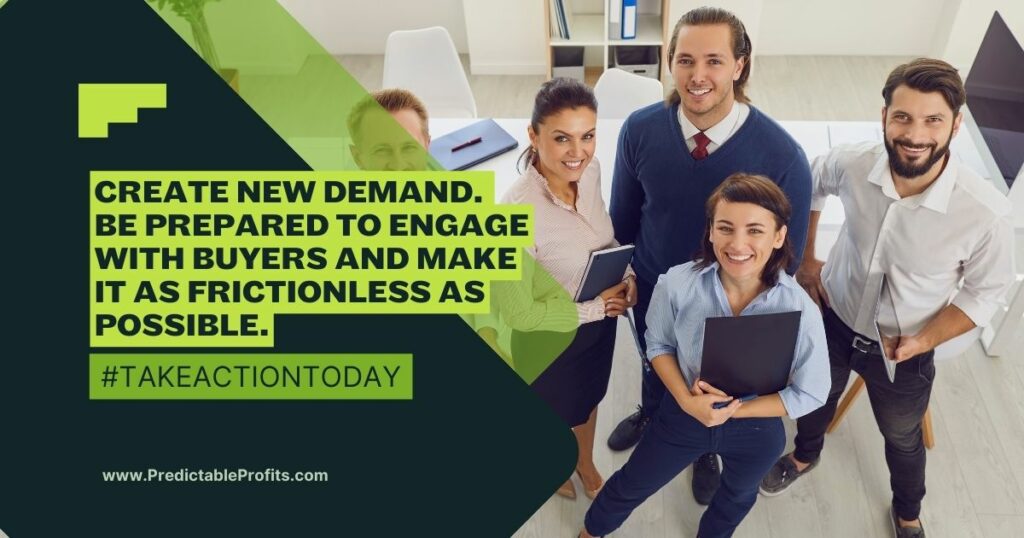
These days, you must be patient and understand that buyers need time to explore options and make informed decisions.
So focus on creating content that educates and informs them at every stage of their journey. Also, have a plan for reaching them where they are —- whether that’s through targeted ads, social media, email marketing, or any other channels.
And finally, be prepared to engage with buyers who are ready to purchase but not commit just yet. Make the experience with you as pleasant and as frictionless as possible.
Remember, buyers today are in the driver’s seat. They make decisions after doing research. So stay patient and be ready to engage with them on their terms.
Be part of our ever-growing community of seven- and eight-figure business owners:
- Check us out on the Predictable Profits YouTube channel.
- Connect with us on Linkedin.
- Join other entrepreneurs (like yourself) on our Facebook page.
- And if you haven’t already, sign up for our daily business coaching video series (by entering your email address below).

